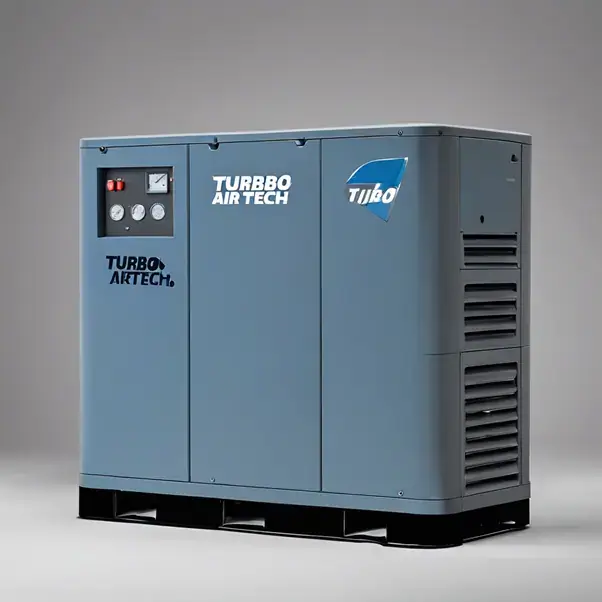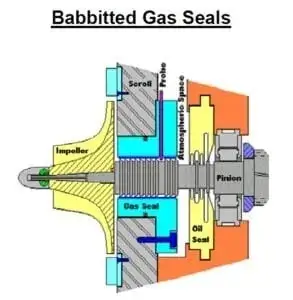
Compressor air seals are a critical component of air compressor systems, and their failure can lead to costly compressor loss and system malfunction.
Let us understand the basics of compressor air seals and their role in maintaining air compressor process seals and prevent atmosphere from entering into the process of gas. We’ll also discuss the benefits of compressor air seals and how they work.
What is a compressor air seal?

Compressor Seal
A compressor process seal (air seal or Gas Seal) prevents the process gas in the compressor from entering the atmosphere using a differential pressure. It also prevents the atmosphere from entering the process gas in the compressor by sealing the rotating assembly in the stationary compressor case. There are three main subsystems in a gas seal system:
- Gas supplies and vents for sealing and separation
- Control panel with piping leading to and from the seals to maintain seal gas
- Quality and seal gas supply pressure to the seal faces. The control panel can use heaters also.
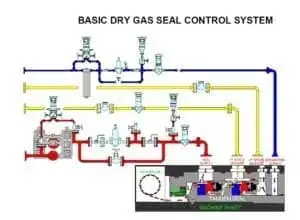
Dry gas Seal Control System
A gas seal housing, including seal faces/surfaces, and/or bushings on the rotors. Typically, the seal gas used to seal the process gas (hydrocarbon, hydrogen) is a clean, dry and cool gas compatible with the process gas that is being compressed.
In order for the seal gas supply pressure to be higher than what the compressor seals will ever be exposed to, filters, dryers, and coolers must be installed in the seal gas supply line. Separation/barrier gas is usually inert gases, such as nitrogen, and should be dry and cool. In most cases, vent systems are connected to a flare or other system where the leakage can be safely disposed of.
How do compressor air seals work?
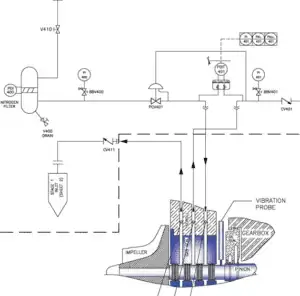
Compressor Gas Seal Working
Compressor air seals (gas seals) work on the principle of” differential pressure control”. As the process gas is pumped through the compressor, its pressure is usually balanced between the discharge seal and the suction seal, so that both seals operate at the same pressure.
A differential pressure gauge and a differential pressure control regulator are connected to the gas seal control panel, which uses the process gas as a control signal. Seal Gas (along with separation gas/inert gas in some cases) is maintained at a “controlled” higher pressure in the machinery, creating a differential thus preventing any leakage of the process gas to the atmosphere.
Benefits of compressor air seals Reliability
A gas seal is a non-contact mechanical seal, so it does not wear. The theoretical lifetime depends only on the secondary seal elements (usually O-ring, gasket or polymer-based seals) that can last for up to 15 years. Dry gas seals typically last for over 10 years before requiring reconditioning, which is much longer than oil seals.
Reduced Maintenance Costs
Routine maintenance is less frequent with gas sealing systems, making them economical.
Reduced Emissions
Thanks to the very thin running gaps between the seal faces, gas leakage is reduced by tenfold. This results in cost savings for the end-user and a reduction in penalties for taxable gas flaring. There are numerous other benefits depending upon system configuration.
Types of compressor air seals Labyrinth seals
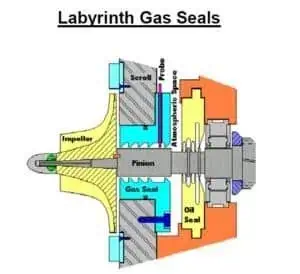
Labyrinth gas seals
The standard gas seal offered on most compressor models used with atmospheric air and low pressure gases allows for a small amount of gas leakage from each compression.
- Non-contacting component and is not subject to shaft wear.
- Does not require periodic maintenance
- Does not require inspection for 5+ years under normal use
Babbitted dry Gas Seals
- Typically used with high pressure and nitrogen applications.
- Knife edges on pinion cut into the Babbitt material on the seal for a close fit with very low gas leakage.
- Not sensitive to the centering of the pinion shaft
- Ports can be machined in the seal to recover gas or buffer the seal during machine downtime.
- Seal maintenance is not required for 5+ years under normal use.

Babbitted gas seals
Dry gas seals can be further classified based on arrangement of the seal faces:
Multiport Babbitted Style dry gas seal
- Lower cost than dry face seals.
- Higher leakage, but some leakage is recovered back to the process.
- Non-recovered process gas is contained and routed to the vent for piping to a safe location.
- Can tolerate some liquids and particulates.
- Greatly simplified seal support system.
Single Dry Face Seal with Labyrinth Separation Seal
- Cartridge style dry gas seals.
- Babbitted separation seal is tolerant of liquids and solids.
- Separation gas requirements are higher than carbon ring type separation seals.
Single Dry Face Seal with Carbon Ring Separation Seal
Dry face and separation seals are supplied as one cartridge style assembly.
Two different styles of carbon ring separation seals:
- Standard segmented carbon ring seal
- Lift off type carbon ring seal
Benefits
- Reduced separation gas consumption as compared to Babbitted separation seal.
- Lift-off type seal ideal for machines spending long periods of time in standby.
- Static leakage is reduced by a factor of 3 as compared to standard carbon ring separation seals.
Tandem Dry Face Seal with Intermediate Labyrinth
- Cartridge style assembly.
- Second dry face seal minimizes leakage to atmosphere in the event of a primary seal failure.
- Reduced separation gas consumption as compared to carbon ring separation seal.
Tandem Dry Face Seal with Carbon Ring Separation Seal
- Cartridge style assembly.
- Leakage across the primary dry face seal faces can be recovered, reducing process gas lost to the vent.
- The carbon ring separation seal prevents process gas leakage into the atmosphere.
- Ideal for closed loop applications where the cost of the process gas is significant.
Double Opposed Dry Face Seal
- The advantage of this seal type is its low seal gas consumption.
- Seal gas leaks into the process and into the atmosphere.
- Maybe be provided with a Babbitted or carbon ring separation seal if seal gas leakage to the atmosphere is not acceptable.
Frequently Asked Questions
The leading cause of dry gas seal failure is contamination inside seal faces. Ingress of solid or liquid into the narrow seal running gap causes the degradation of seal performance (higher leakages) and ultimate seal failure. The primary source of gas seal contamination is seal gas supply. Seal gas supply needs to be treated well using an air filter at the upstream of the dry gas seal. The purpose of seal gas conditioning system is to reduce the contamination of seal gas supply and ultimately increase the dry gas seal life of the compressor.
A compressor air seal works by using knife edges or air pressure to create a differential pressure control to prevent or minimize process gas leakage into the atmosphere.
Sealing air is air that is injected into the compressor in order to prevent process gas leaking into the atmosphere. The sealing air uses the buffer gas system and vent system and works on the principle of differential pressure.
Conclusion
Compressor air seals are a crucial part of compressed air systems and air compressors. By sealing the compressor in a wet environment, compressor air seals help to prevent dirt, dust, and other contaminants from entering the compressor. </p><p>This prevents damage to the compressor and ensures that the compressed air system runs at optimum. In addition to preventing damage, compressor air seals also have a number of other benefits, such as improved air quality and longer compressor life. For any requirement of compressor parts or technical information, feel free to contact Turbo Airtech. We will be happy to assist.


